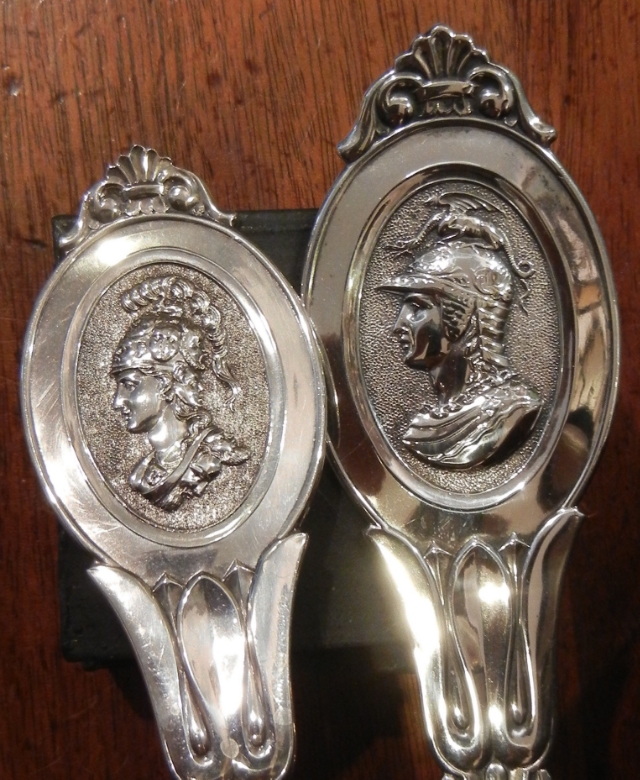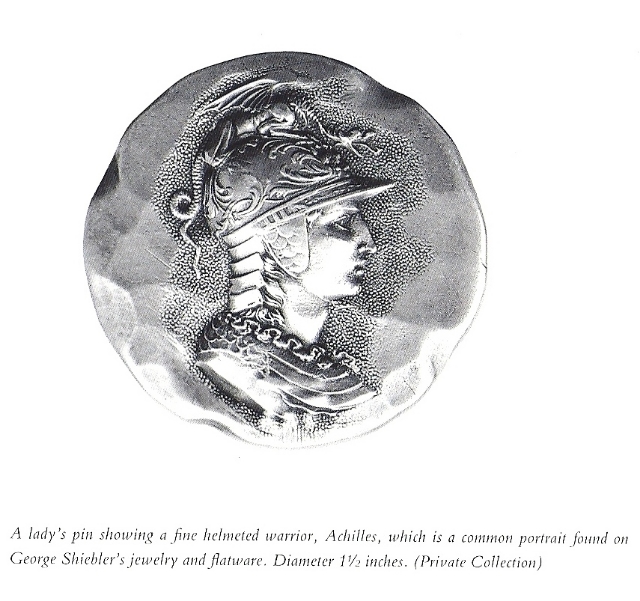|
A GLOSSARY of MILLED BANDS
|
|
| How to Post Photos |
REGISTER (click here)
|
|
A GLOSSARY of MILLED BANDS
|
|
| How to Post Photos |
REGISTER (click here)
|

|
 SMP Silver Salon Forums SMP Silver Salon Forums
  American Silver before sterling American Silver before sterling
  Freeman Durgin Freeman Durgin
|
| next newest topic | next oldest topic |
| Author | Topic: Freeman Durgin |
|
ahwt Posts: 2334 |
  
 Above are two ladles made by Freeman Durgin of St. Louis. The one on the left was subject to another thread (Great faces in silver -- medallions) and had the unusual feature of having small faces concealed in the face. It was retailed by W.C. Defriez also of St. Louis. The one on the right was retailed by E. Mead, again a St. Louis merchant. The Mead ladle has a medallion depicting Achilles that was taken from an engraving in Knight’s Gems or Devices. Wood and Hughes and Shiebler also used Knight’s engraving. Does anyone know why Achilles has a dragon like creature sitting on his helmet? IP: Logged |
|
jersey Posts: 1203 |
  
Hello again ahwt. Are you sure that is Achilles ? Jersey IP: Logged |
|
ahwt Posts: 2334 |
  
 This photo is from page 20 of Soeffing’s book Silver Medallion Flatware. The reference to Knight’s book came from a commercial site, but that site had the same picture. The only difference is that the face on Shiebler’s work is facing right rather that the natural left facing pose shown by Knight and Freeman Durgin. It could be that the dragon was just part of the artistic license taken by the engraver in Knight's book and had nothing to do with the mythology surrounding Achilles. IP: Logged |
|
dragonflywink Posts: 993 |
  
Lovely ladles - I am always so amazed at the skill of the usually unsung die-cutters. Used to reread my Hamilton's Mythology every few years, but it's been a while (even longer for The Iliad and The Odyssey), but right off hand, can't recall a dragon symbolism for Achilles - suspect the 'artistic license' theory is correct. Knight's Gems or Device Book (1820): ~Cheryl IP: Logged |
|
Scott Martin Forum Master Posts: 11520 |
  
Found this in some old photos.. just sharing IP: Logged |
|
ahwt Posts: 2334 |
  
From a book I recently came across on Google Books: A Tour Of St. Louis: Or The Inside Life Of A Great City (1878) F. A. DURGIN . - MANUFACTURER OF SOLID SILVERWARE. To the St. Louis visitor of aesthetic taste, whose pleasure is found in the admiration of the most elegant products of man's ingenuity, no place within the limits of the great metropolis will afford so much interest as the extensive solid silverware manufactory of F. A. Durgin , located at No. 305 Ņorth Seventh Street . The foundation of this elaborate in stitution was laid by the present proprietor in 1858, in a small building on the corner of Market and Commercial streets . The necessity for subsequent changes caused three removals of the business , first , to the corner of Fourth and Spruce streets ; next to the corner of Fifth and Pine , up stairs; and in 1868 to the present premises . The last removal was of the greatest importance, for the building was fitted up specially for a manufactory, and was of proper dimensions to admit of the most extensive manufacturing and retail business . Steam power was added, together with all the necessary machinery for converting silver bricks into the most elegant ornaments of table use and personal adornment . The processes through which the pure silver passes from the brick or coin into the numerous articles so skillfully designed and executed , is full of absorbing interest to every visitor , whether he be a novice or the most critical connoisseur of the fine arts . Upon entering the room the first object of the rear of the factory are two crucibles , through which the alloyed silver passes and comes out pure and beautiful . The hum of numerous appliances makes the place musical , and upon reaching the second story the visitor finds so many interesting features that his stay is necessarily prolonged far beyond the time he had allotted . The fashioning of thin plates of silver into pitchers , sugar bowls , castors , butter dishes , the beautiful repousse work , or hammered silver , and a thousand articles of like character , is a process which excites the most profound in terest . An attempted description of all the means employed would be futile and unsatisfactory , for nothing can approximate the scene . All our readers , beyond a doubt , have often won dered how silverware is polished ; true , they all know that the use of a special preparation and a vigorous rubbing with chamois skin will thoroughly cleanse silver , but yet no such means will impart to the ware that bright , satin finish which is seen upon the new articles exposed for sale . The process employed by the manufacturer is a very simple one . Upon one end of a rod , which is made to revolve with the greatest rapidity , like a turning lathe , is fastened the burnishing brush . This brush consists of a ball of small brass wires , about one inch in length , fastened loosely at one end to a center piece by the union of two rings . The small wires are therefore free to dangle , and when the machine is set in . motion the centrifugal force throws the wires freely outward . Against these the article desired to be polished is held , and the beautiful gloss at once appears , and in a very few moments the pitcher , dish , or whatever it may be , is ready for sale . In addition to the immense manufacturing interests of Mr. Purgin , he gives special attention to engraving , keeping constantly employed two of the most skillful and expert work men in the country , and doing the finest work in the city . The salesroom of this great establishment is one of the most elegant and elaborate to be found either East or West. In the arrangement of the cabinet show - cases, which are of solid walnut, richly embellished with the genius of the most expert wood carver, Mr. Durgin has exhibited the most refined and tasteful conception . These cases extend in an upright [This message has been edited by ahwt (edited 12-02-2020).] IP: Logged |
|
ahwt Posts: 2334 |
  
Description from the Metropolitan Museum of Art a Durgin medallion ladle depicting Achilles Soup Ladle F. A. Durgin On view at The Met Fifth Avenue in Gallery 774 The mid-nineteenth century witnessed an efflorescence of creativity in the American silver industry, fueled by the burgeoning middle class’s increasing demand for refined luxury goods. Silversmiths devoted considerable time and creative energy to generating an endless variety of new designs and patterns. During the 1860s and 1870s silver flatware ornamented with portrait medallions inspired by antique coins and cameos enjoyed widespread popularity, with virtually every American silversmith producing their own proprietary "medallion" pattern. The Saint Louis, Missouri firm of F. A. Durgin created this ladle, the shank of which bears marked similarities to the earliest known medallion pattern patented by New York silversmith John R. Wendt in 1862. (See for example TR.572.7.) Although his pattern is not a copy, it is clear Durgin was familiar with Wendt’s design. An 1878 publication entitled A Tour of St. Louis celebrates Durgin’s firm for "elevating the tastes of our people to the very highest appreciation of fine art," and goes on to report that Durgin "turns out the most elegant articles of solid silverware to be found in the United States….and the superiority of his work has secured for him the patronage of the best and wealthiest citizens of the West." [This message has been edited by ahwt (edited 12-02-2020).] IP: Logged |
|
June Martin Forum Master Posts: 1326 |
  
Great update to the thread. Thanks ahwt. IP: Logged |
|
ahwt Posts: 2334 |
  
June, I saw the article about Durgin's ladle on the Met's website and must admit I got a little chuckle with their statement: "Although his pattern is not a copy, it is clear Durgin was familiar with Wendt’s design." They may be surprised, but by the 1860s many of the innovations made in New York actually made their way to St. Louis. The MET also did something that I really do not see very often and that is restrict use of the photo. Their close up of the cap on the medallion is off center and must have been the result of photo editing as the image of the full ladle shows the cap in the correct position. IP: Logged |
All times are ET | next newest topic | next oldest topic |
  |
|
Ultimate Bulletin Board 5.46a
|
1. Public Silver Forums (open Free membership) - anyone with a valid e-mail address may register. Once you have received your Silver Salon Forum password, and then if you abide by the Silver Salon Forum Guidelines, you may start a thread or post a reply in the New Members' Forum. New Members who show a continued willingness to participate, to completely read and abide by the Guidelines will be allowed to post to the Member Public Forums. 2. Private Silver Salon Forums (invitational or $ donation membership) - The Private Silver Salon Forums require registration and special authorization to view, search, start a thread or to post a reply. Special authorization can be obtained in one of several ways: by Invitation; Annual $ Donation; or via Special Limited Membership. For more details click here (under development). 3. Administrative/Special Private Forums (special membership required) - These forums are reserved for special subjects or administrative discussion. These forums are not open to the public and require special authorization to view or post. |
|
copyright © 1993 - 2022
SM Publications
All Rights Reserved. Legal & Privacy Notices |